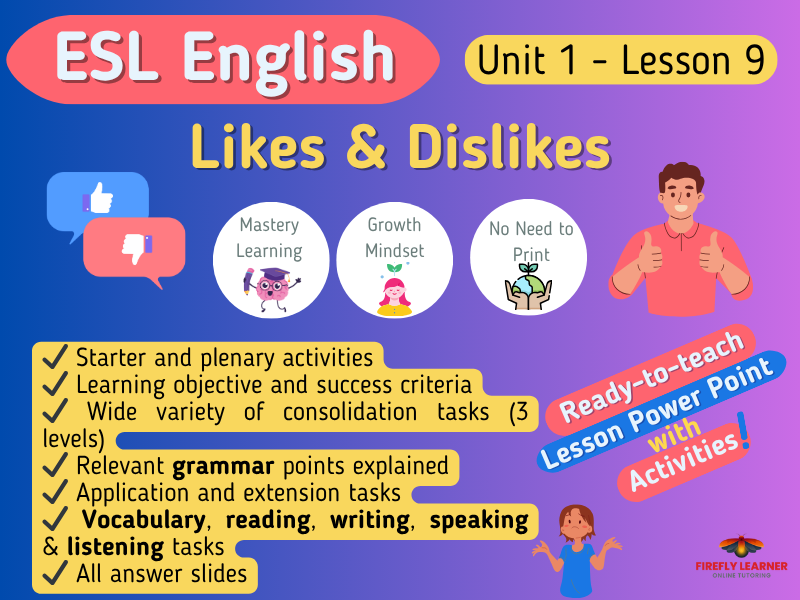

This is a PowerPoint presentation covering the following:
Vocabulary: like(s), love(s), enjoy(s), dislike, donŌĆÖt mind, hate, does, doesnŌĆÖt, does not, do, donŌĆÖt, do not, cooking, baking, watching, playing, reading, writing, swimming, walking, running, dancing, painting,
Key Concepts Covered:
- Asking someone what they like/ love/ enjoy doing
- Making statements about what I like/ love/ enjoy doing
- Making statements about what a third party likes/ loves/ enjoys doing (He likesŌĆ” They loveŌĆ” My parents enjoyŌĆ” etc.)
- ŌĆśLikeŌĆÖ and ŌĆśloveŌĆÖ can be followed by verbs in the infinitive form (to + base tense) OR the continuous form (ending in -ing) whereas when ŌĆśenjoyŌĆÖ is followed by a verb, the verb must be in its continuous form.
- When the subject is plural or ŌĆśIŌĆÖ or ŌĆśyouŌĆÖ, we do NOT add an ŌĆśsŌĆÖ on the end of the first verb (e.g. They likeŌĆ”, We loveŌĆ” I enjoyŌĆ” etc.) where as when the subject is singular, it is followed by a verb with an ŌĆśsŌĆÖ on the end (e.g. He likesŌĆ”, She lovesŌĆ” It enjoysŌĆ” etc.). This is the subject-verb agreement rule.
- How to make statements negative by adding ŌĆśdoesnŌĆÖt/ does notŌĆÖ before the verb when the subject is singular or ŌĆśdonŌĆÖt/ do notŌĆÖ when the subject is plural, ŌĆśIŌĆÖ or ŌĆśyouŌĆÖ (She doesnŌĆÖt likeŌĆ” They donŌĆÖt enjoyŌĆ”etc.)
- When to use ŌĆśdoesŌĆÖ and when to use ŌĆśdoŌĆÖ
LO: To talk about what I and others like and dislike.
Success Criteria:
I can name and identify a variety of activities that people do.
I can talk about things that I like, love and enjoy doing.
I can talk about things that I donŌĆÖt like, love or enjoy doing.
I can talk about things that others like, love and enjoy doing.
I can talk about things that others donŌĆÖt like, love or enjoy doing.
I can use the contracted form of ŌĆśdo notŌĆÖ (donŌĆÖt) and does not (doesnŌĆÖt).
I know that we can follow the verbs ŌĆślikeŌĆÖ and ŌĆśloveŌĆÖ with another verb in its imperative form (to + base tense) or its continuous form (ending in -ing) whereas when the verb ŌĆśenjoyŌĆÖ is followed by another verb, the second verb must be in its continuous form.
I know that when the subject is singular, we add an 'sŌĆÖ onto the first verb whereas when the subject is plural, ŌĆśIŌĆÖ or ŌĆśyouŌĆÖ, we do not add an 'sŌĆÖ onto the verb.
Whether you teach English online, face-to-face, one-to-one or to a whole class of students, this sixty-two slide PowerPoint presentation is perfect for teaching ESL learners.
This is a PowerPoint presentation which includes everything you need to teach an English lesson either online or face-to-face. It can be used with both one-to-one students and whole classes.
The presentation includes the following:
Ō£ō Learning objective and success criteria
Ō£ō Starter and plenary activities
Ō£ō Assessment of prior knowledge
Ō£ō Teaching input (vocabulary & meanings, sentence construction, grammar points etc.)
Ō£ō Independent and team consolidation tasks (3 levels)
Ō£ō Speaking, reading, writing and grammar tasks
Ō£ō Application activities and support slides
Ō£ō All answer slides
Something went wrong, please try again later.
This resource hasn't been reviewed yet
To ensure quality for our reviews, only customers who have purchased this resource can review it
to let us know if it violates our terms and conditions.
Our customer service team will review your report and will be in touch.